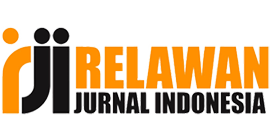Member of
Instructions for Authors Journal Riset Komunikasi (JURKOM)
- Articles written for Junal Riset Komunikasi (JURKOM) includes articles the results of research in the field of communication.
- Articles are written in Indonesian or English. Manuscripts are typed in the Microsoft Word program, Times New Roman letters are 12 pts in size, 1.15 spaces, standard margins (top 2.5 cm, bottom 2.5 cm, outside 2.5 cm, and inside 2.7 cm), A4 paper size 15-25 pages long.
- The systematics of the research results is the title, author's name (accompanied by institutional address, telephone number, and e-mail address), abstract / abstract (accompanied by keywords), introduction, research method, results of research and discussion, conclusions, and bibliography.
- The title of the article in Indonesian is no more than 12 words, whereas in English no more than 10 words. The title is written in the middle, with a letter size of 16 pts.
- The author's name for the article is included without an academic degree, accompanied by the name and address of the institution, and placed below the article title. If the text is written by a team, the editor is only related to the main author (the author whose name is listed first).
- Abstracts and keywords are written in two languages (Indonesian and English). The length of each abstract is 100-150 words, accompanied by keywords of 3-5 words. Minimal abstract contains problems, objectives, methods, concepts, and results of research and discussion.
- The introduction to the article results of the study contains the background, the research context, the results of the literature review, and the research objectives. All introductory sections are presented in an integrated manner in paragraphs, with a length of 15-20% of the total length of the article. The introduction section does not need to be given an introductory sub-title.
- The method section contains exposure in paragraph form about research design, data sources, data collection techniques, and data analysis conducted by researchers, with a length of 10-15% of the total length of the article.
- The research results section contains exposure to the results of the analysis relating to the research questions. The discussion contains the meaning of results and comparison with the theory and/or results of similar research. The length of exposure to results and discussion is 40-60% of the length of the article.
- The core section or discussion for conceptual articles contains exposure to the author's analytical or argumentative, logical, and critical analysis or thinking. Exposure to the discussion contains the author's position or attitude on the issue being discussed. The length of exposure to the core section or discussion is 60-80% of the length of the article.
- The closing section contains conclusions, affirmations of the position or attitude of the author, and suggestions. Closing is presented in paragraph form. Length of cover exposure is 10-15% of the length of the article.
- All texts are reviewed anonymously by reviewers (mitra bestari) appointed by the editor according to their expertise. The author of the article is given the opportunity to make improvements (revisions) to the script on the basis of recommendations/suggestions from reviewers or editor.
- Everything related to the licensing of quotations or the use of computer software for the production of manuscripts or other matters relating to intellectual property rights carried out by the author of the article, along with legal consequences that may arise as a result, are the full responsibility of the article's author.
- The reference list only contains the sources referred to in the article, and all sources referred to must be listed in the reference list. The reference source of at least 80% is in the form of literature published in the last 10 years. The references used are primary sources in the form of research articles in journals or research reports (including theses and dissertations).
- Referrals and citations use enclosed reference techniques (last name, year). Inclusion of sources in direct quotations should be accompanied by a description of the page number where the quote originated. Example: Seitel (2009: 87) or (Seitel, 2009: 87).
- The reference list is compiled in reference to the 6th edition of the APA Style such as the following example and is described alphabetically and chronologically:
Single author book
Eriyanto (2014). Analisis Jaringan Komunikasi. Jakarta: Prenada Media Group
Prell, C. (2013). Social Network Analysis: History, Theory & Methodology. London: Sage Publications.
Book with two to seven authors
Hamilton, J. M., & Krimsky, G.A. (1996). Hold the press: The inside story on newspapers. Baton Rouge: Louisiana State University Press.
Wong, D. L., Hockenberry-Eaton, M., Wilson, D., Winkelstein, M. L., Ahmann, E., & DiVito-Thomas, P. A. (1999). Whaley & Wong's nursing care of infants and children (6th ed.). St. Louis: Mosby.
E-book:
Gray, J., Bounegru, L., & Chambers, L. (2012). The Data Journalism Handbook. Sebastopol, CA: O’Reilly Media. Tersedia dari http://datajournalismhandbook.org/1.0/en/
Articles in the article collection book:
Pontoh, C. H. (2013). Konflik Tak Kunjung Padam. Dalam Triharyanto, B. & Salam, F. (Eds), Dapur Media: Antologi Liputan Media di Indonesia (h. 43-93). Jakarta: Pantau.
Bergquist, J. M. (1992). German Americans. In J. D. Buenker & L. A. Ratner (Eds.), Multiculturalism in the United States: A comparative guide to acculturation and ethnicity (pp. 53-76). New York, NY: Greenwood.
Journal Article:
Brady, D., & Webb, N. (2013). Communicating bushfire safety in Australia: the challenge for government of increasing community participation. Asia Pacific media educator, 23(2), 351-365.
Article Journal with DOI:
Knight, M. (2015). Data Journalism in the UK: A Preliminary Analysis of Form and Content. Journal of Media Practice 16 (1): 55-72. doi: 10.1080/14682753.2015.1015801.
Conference Paper:
Jongeling, S. B. (1988, September). Student teachers’ preference for cooperative small group teaching. Paper Presented at The 3rd Annual 13 Research Forum of the Western Australian Institute for Educational Research, Murdoch University, Murdoch, Western Australia.
Articles on the internet:
Massy, W. F. & Robert, Z. (1996). Using Information Technology to Enhance Academic Productivity. Diperoleh dari (www.educom.edu/program.nlii/keydoces/massy.htm)
Newspaper Articles:
Iskandar, A. (2017, Desember 28). Sumber Energi Peredaran Gelap Narkotika di Indonesia. Media Indonesia, hal. 8.
Posts/news in newspapers without the author:
Perlu Kearifan Memanfaatkan Teknologi. (2017, Desember 28). Riau Pos, hal. 17.
Online media articles:
Kasali, R. (2017, Desember 28). Arah Tranformasi dan "Digital Crisis" 2018. Kompas. Diperoleh dari http://ekonomi.kompas.com/read/2017/12/28/070000926/arah-tranformasi-dan-digital-crisis-2018
Official document:
Badan Pusat Statistik Provinsi Riau. (2017). Provinsi Riau Dalam Angka 2017. Pekanbaru: Badan Pusat Statistik Provinsi Riau.
Thesis, Dissertation, Research Report:
Muchlis, F. (2017). Praktik Komunikasi dalam Pemberdayaan Orang Rimba di Taman Nasional Bukit Duabelas Provinsi Jambi. (Disertasi tidak diterbitkan). Institut Pertanian Bogor, Bogor, Indonesia.
Website:
Data Driven Journalism. (2017). Tersedia dari: http://datadrivenjournalism.net/
Blog:
Rogers, s. (2015, June 28). Data journalism in China. [Web log post] https://simonrogers.net/2015/06/28/data-journalism-in-china/
















